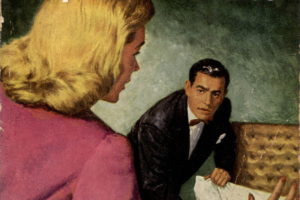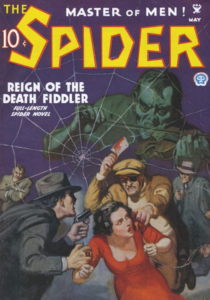
“Reign of the Death Fiddler” was originally published in the May 1935 issue of The Spider Magazine. The Death Fiddler — master of the grotesque, he held an entire city in the strangle-hold of a helpless terror; even the forces of the Law stood in shuddery, superstitious fear of this new destroyer. The Spider, too, was baffled; not all Richard Wentworth’s efforts seemed enough to destroy this new, this ugliest of all Hydra heads rearing out of the noxious slime of the Underworld…
Here’s a pretty much routine Spider story. Not the best; not the worst. Not over-the-top crazy; but certainly not boring. The ending winds up nicely, and doesn’t have the rushed feeling that some stories have. There is no weird menace, here… Okay, maybe just a touch… but basically it’s a crime story about an underworld boss who threatens the safety of the city. This time around, there’s no threat that encompasses the entire nation. It’s restricted to New York City. There are a few loose ends that are never tied up, but it’s not too blatant this time around. So, here we have a fun Spider story with plenty of shooting and falling bodies. There’s the usual non-stop action, and it makes for a very enjoyable, if somewhat standard, story.
As our story opens, we are in the middle of a crime wave that has been going on for three months. Now given that there have been 20 robberies every night for such a lengthy period of time, it seems that The Spider would have mopped up the gang by now. But apparently he’s been otherwise engaged, because in the opening scene, we learn that he doesn’t know much about the crime surge. He doesn’t know the gang or who’s in it; he doesn’t know what the chief villain calls himself. He’s never seen “the mark” of the mastermind. Nothing…
Political protection for The Death Fiddler
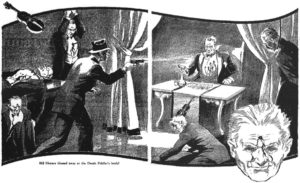
But whoever is behind this reign of lawbreaking must have some strong political clout. In all these crimes, many had been arrested, but strangely few came to trial. And even when they did, witnesses disappeared. Yes, the underworld had political protection, which gives the gangs of New York license to do pretty much what they please.
So Richard Wentworth has left his life of luxury and come down to the Bowery to live under the assumed identity of Limply Magee, owner of a second-hand shop. From what I can tell, this is a new disguise, not one used in previous stories.
Limpy Magee hears Danny Dawson, a master cracksman, tell a barkeep he has a job that night. Limpy follows him, helps him evade the police and becomes his fast pal. Using his new credentials as Danny’s crony, he gains entry into an underworld hangout called Collins’ Saloon. And there he runs into the mastermind behind this whole crime wave.
At Collins’ place, we first meet the underworld mastermind. He likes to disguise himself as his future victims. So he appears as Judge Scott, complete with bullet holes in his chest. This is Wentworth’s first chance to kill the guy, but naturally he doesn’t. That would have made for a very short story. So, he waits.
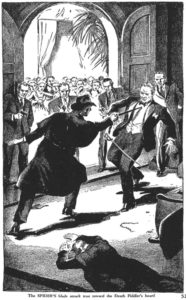
Here’s one of those inconsistencies that always nag at me. We’re told that for 12 weeks, there have been murders every Thursday night at 11:30 p.m. A crook tossed from a window. A woman clubbed. A millionaire strangled in his sleep. And tonight, Judge Scott will be shot to death. The inconsistent part is that later we are told that this mastermind is a gentleman crook. He renounces violence toward women. We even have several scenes where he kills his own men for attempting such violence toward women. Yet among those Thursday night victims was a woman. The discrepancy is never explained, but continues to bug me.
Oh yeah, at Collins’ saloon there is a cheap floozy named Snakey Annie. She puts the moves on Limpy Magee, alias Richard Wentworth. I found it somewhat amusing to watch him try to avoid her advances. Nothing really comes of this sub-plot, and she disappears halfway through the story. But while she was there, her presence was a plus.
Enter Bill Horace
While in the same scene set in Collins’ Saloon, we first meet Bill Horace, a policeman. He’s there to pull his brother and girlfriend out of the dive, but eventually goes on to play a good-sized part in the story, helping Limpy Magee, also known as The Spider.
Later, Limpy stops a street gang from killing an old peddler woman. Actually, it’s Nita van Sloan in disguise. He shoots one of the two thugs, the other is killed by none other than the underworld mastermind in the guise of Judge Scott. Yes, he eschews violence toward women (ignoring the one he clubbed to death weeks earlier) and is a gentleman. The Spider has his second chance to kill the mastermind, but again stays his hand. The Spider has grudging respect for him. Oh come on! Really? Just kill the guy!
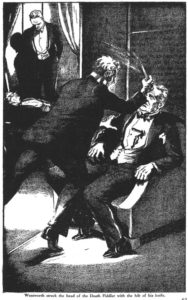
Anyway, the fake Judge Scott presses the ferrule of his cane to the cheek of the thug he shot. It sizzles the flesh, leaving a small brownish burn in the shape of a small violin. It’s a bit later that we learn he calls himself The Death Fiddler, and this all starts to make sense.
Limpy Magee presses his cigarette lighter to the forehead of the other dead thug and identifies himself as The Spider. The Fiddler has met The Spider. Both respect each other, and refuse to kill the other. As this point, I was mentally screaming “Shoot the duck! Shoot the duck!” in my best Daffy Duck imitation. (I refer here to a classic Warner Brothers cartoon Duck! Rabbit, Duck! with Bugs Bunny, Daffy Duck and Elmer Fudd. If you’ve seen it, you’ll understand.) But neither shoots the other, and both live to regret it.
And now, the highpoints
There’s plenty that happens in this story, as is typical of these mile-a-minute whirlwind Spider tales, and I’m only going to hit the highpoints. Career politicians ask Wentworth’s good friend Police Commissioner Stanley Kirkpatrick to run for governor. And it’s a convenient thing they do, because shortly thereafter he receives a letter from the mayor demanding his resignation. The reason for the demand is a big vague, but let’s not pick nits on details.
One of those nagging unresolved plot threads occurs about here in the story. An important man is kidnapped… and then that whole angle of the story is dropped. John K. Barnfeller has received a demand for a hundred thousand dollars from the Death Fiddler, and he has refused to pay. The Death Fiddler vows to kidnap him tonight. Kirkpatrick and Wentworth set out to thwart the kidnap attempt but fail. Twenty policemen are murdered and one of the world’s wealthiest capitalists has been kidnapped on the streets of New York. And then… well, that’s pretty much the end of it. Everybody moves on to other aspects of the case, and we never hear any more about old Barnfeller. Was he killed? Rescued? Ransomed? If it was important enough to include this chapter in the book, why not wrap it up? Ah, frustration… thy name is Spider.
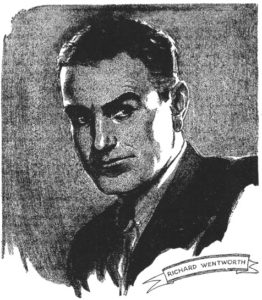 One of the underused aspects of the Death Fiddler’s persona is that he seemingly can’t be killed. He likes to disguise himself as his future victims. He also litters his headquarters with wax dummies of his past victims, showing their wounds all in gory detail. In one scene, he’s shot five times in the chest, but doesn’t die. In other scene, he has a rapier duel with The Spider, and The Spider thrusts the tip deep into his heart… yet it doesn’t affect him. There was no rapier-proof vest, we’re told… the tip actually did penetrate. Yet the man lives.
One of the underused aspects of the Death Fiddler’s persona is that he seemingly can’t be killed. He likes to disguise himself as his future victims. He also litters his headquarters with wax dummies of his past victims, showing their wounds all in gory detail. In one scene, he’s shot five times in the chest, but doesn’t die. In other scene, he has a rapier duel with The Spider, and The Spider thrusts the tip deep into his heart… yet it doesn’t affect him. There was no rapier-proof vest, we’re told… the tip actually did penetrate. Yet the man lives.
I think this angle should have been played up more. But it’s just mentioned a couple of times and never exploited properly. In the end, we’re told that the Death Fiddler sometimes uses wax dummies of himself. That might explain his escaping death by gunshot, but certainly doesn’t explain the rapier thrust to the heart. That was no wax dummy dueling with The Spider. It was a real man. And so, here’s another loose plot thread that is never explained. And frustratingly so!
Shoot the duck!
Another frustrating thing about this story is the number of times that The Spider encounters the Fiddler and has the chance to kill him, but refrains from doing so. Then later, he regrets his decision. The Death Fiddler commits some heinous act, and The Spider vows that next time he’ll shoot the man on the spot. But… he doesn’t. Over and over he keeps changing his mind, making it really frustrating. Make up your mind. Shoot the duck!
 Another of those annoying loose ends that I just have to mention is a large battle at the Bal Masque at the Tory Hotel. Atrocities galore. Police finally rout the gang, chasing them upward into the hotel. The entire gang simply disappears. We’re not talking about just a few guys, but nearly 50! And there’s never an explanation of how they can completely disappear from the upper floors of the hotel. I figured there would be some explanation at the story’s end, but no. It’s annoying when these unexplainable things happen. They need to be explained, even in casually in passing, by the end of the tale.
Another of those annoying loose ends that I just have to mention is a large battle at the Bal Masque at the Tory Hotel. Atrocities galore. Police finally rout the gang, chasing them upward into the hotel. The entire gang simply disappears. We’re not talking about just a few guys, but nearly 50! And there’s never an explanation of how they can completely disappear from the upper floors of the hotel. I figured there would be some explanation at the story’s end, but no. It’s annoying when these unexplainable things happen. They need to be explained, even in casually in passing, by the end of the tale.
I’ve gotten used to the frustration of working with the police. It happens in every Spider novel, and I’m used to it by now. As is typical in Spider stories, our hero warns the police of impending crime. They laugh and ignore him. They continue to ignore him even when it’s proved that his warnings are valid. This time around, he calls the new commissioner Flynn and warns him about an impending museum robbery. Flynn laughs. The museum curator doesn’t believe him. He is unable to convince the Mayor. And of course, the robbery goes off without hinderance. The police are portrayed as hard-headed boobs in these stories.
There are some pretty cool scenes in this story, for all my frustrations with it. One of my favorites takes place in Macy’s department store as it is being sacked by the Death Fiddler and his mob. Wentworth creates an impromptu Spider disguise from clothes in the Men’s Department. Then he lassoos the Death Fiddler with his silk Spider cord, and hangs the man. Of course, it turns out to be a lieutenant of the mastermind in Fiddler disguise, not the Fiddler himself. But it’s still a great scene.
One of the neat things I found in this story is reference to a shallow tray beneath the rear seat of the Lancia. There are nested revolvers, automatics, bombs, rifles, riot gun, submachine gun. Wow! The Spider has a whole arsenal hidden in his car! In today’s world, if he tried to make it through customs across a border crossing, he’d be in big trouble. But keep in mind, this is fiction… make believe… pulp.
Jackson — back from the dead
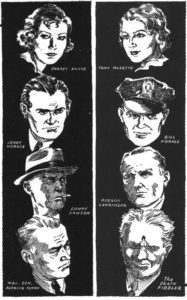
This Spider story is probably best known for the one in which Jackson returns from the dead. You see, three issues earlier in the February 1935 issue of the magazine in the story “The Pain Emperor,” Jackson, The Spider’s friend and chauffeur, was killed. With his dying breath, he accepted blame for all The Spider’s crimes. All to let his beloved friend off the hook. But now, he’s back. At the story’s end, Jackson explains how he escaped death, but it didn’t make a lot of sense to me. I guess I should have read “The Pain Emperor” first. But it’s good to see him back.
Since he confessed to being The Spider before he died, there is still that issue hovering above him, now that he’s alive and back. Will he be prosecuted for being The Spider? It’s left rather vague. Jackson jokes that maybe he is his twin brother. Wentworth intends to find another name for Jackson. But nothing is decided as the story ends.
Oh, yeah, in the end, Stanley Kirkpatrick “will undoubtedly be elected governor.” And all this without doing any campaigning, it seems. Ah, you gotta love politics!
So, one more question… unresolved question, unfortunately. Why the regular Thursday night murders? Why always at 11:30 p.m. Thursdays? It’s never explained. Just one more of those little quirks that criminal masterminds seem to have, I guess.
Ending with a whimper, not a bang
The ending of this story is a bit of a letdown. There is no great battle. No saving hundreds of people from certain peril. No. The Spider breaks into an upstairs hotel room. A man stands by a microphone. The Spider shoots him. It’s the Death Fiddler. We learn his true identity (which I won’t reveal here). Quite a letdown from the typical Spider ending where the master villain is killed just as his hand is about to descend upon the switch which will release a reservoir filled with acid upon a crowd of hundreds of innocent men and woman. Sorry, nothing like that, here. Just an empty room with one man. A single gunshot. The End.
Oh, by the way. This story was originally titled “Kingdom of Crime” but was changed by the editors to what was finally the published version, “Reign of the Death Fiddler.” I will admit I like the new title better. Good call.
As all fans of The Spider know, these are currently available, reprinted for today’s audience in paperback and ebook formats. So if you have a mind to read this one, it’s not that hard to find.
I found some things to like in this Spider story, and some things to not like. But in both cases, the feeling wasn’t extreme. It was more tepid. And that might describe the story itself, as well. Fun, but not outstanding.
